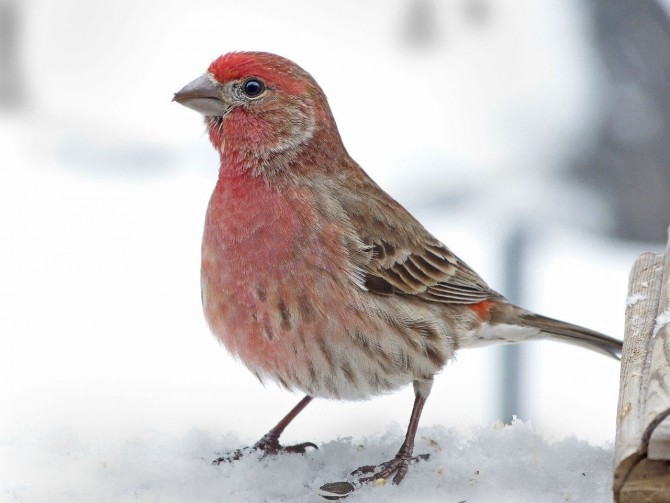House finches with pink eye reveal the secrets of disease virulence
By Gustave Axelson
Most pathogens have a natural incentive not to make their hosts too sick, too fast, lest they kill off the organism they’re living within before they can replicate and spread – or at least that’s the conventional wisdom among epidemiologists.
But in the case of conjunctivitus among house finches, the bacteria Mycoplasma gallisepticum takes a different tack: ramp up the virulence, and give the birds a severely nasty case of pink eye.
It’s all part of a pathogen strategy to overcome the immune systems of these common rosy backyard birds, according to research published March 2 in the journal Science. The findings – from researchers at Cornell, Virginia Tech, Princeton, San Diego, and North Carolina State universities – show that this strategy makes the pathogen much stronger and more dangerous for its next victim.
The high-virulence strategy aims to exploit the incomplete memory of natural immune systems and create a pathway for re-infection. Unlike humans, wild birds do not receive vaccines and must rely on their natural immune systems to protect them from pathogen attacks. Epidemiologists explain that natural immune systems have the capacity for so-called memory to recognize past abusers and ward them off. However, sometimes those memories aren’t perfect, granting only incomplete immunity – and leaving the door open a crack for reinfection. In this study, bacteria causing more severe disease barged their way in to re-infect the house finches, because higher virulence overcame the host’s imperfect immunity.
Over time, the studied environment of the house finches’ incomplete immunity to mycoplasmal conjunctivitis favored the evolution of more virulent pathogen strains that caused more severe disease to previously unexposed house finches. The study then modeled this pathogen–host environment and found that the pathogen strains that came to dominate were almost twice as deadly to hosts.
“Our results are not just important for finches. Many human pathogens and other animal pathogens also cause only incomplete protection against reinfection,” said Dana Hawley, senior author on the research and associate professor of biological sciences at Virginia Tech. “In this case, imperfection can be deadly.”
The Cornell Lab of Ornithology’s André Dhondt and Wesley Hochachka are coauthors of the study, which was built on a body of research about house finch eye disease started by Dhondt in the Cornell Lab’s Bird Population Studies program two decades ago.
“When we started the study of a new disease in House Finches in 1994, we had no idea where this would lead. We were able to follow the expansion of the epidemic across North America thanks to the citizen-science network of the Cornell Lab, and funded by the visionary new federal Ecology and Evolution of Infectious Diseases program,” said Dhondt, noting that the research benefited greatly from grants from the National Science Foundation and National Institutes of Health.
Samuel Scheiner, an NSF program officer who managed the grants for the House Finch Mycoplasma research, said the link between House Finches with pink eye and diseases that threaten humans is a key to this research funding.
“The outbreak of Zika [was] due to some kind of mutation that occurred somewhere in Asia and suddenly made Zika more virulent,” said Scheiner. “The idea is that you can use things like the house finch project as a way to study those processes, and then you can apply that knowledge to things like the Zika outbreak.”
Dhondt says this latest publication is another piece added to solving the puzzle of how house finch eye disease works: “The experiments reported in the Science paper explain elegantly why pathogen virulence increased once the disease had become established. And it’s more evidence of how curiosity-driven research on birds can generate insights that are relevant for human health.”
Gustave Axelson is editorial director of the Cornell Lab of Ornithology.
Media Contact
Get Cornell news delivered right to your inbox.
Subscribe

